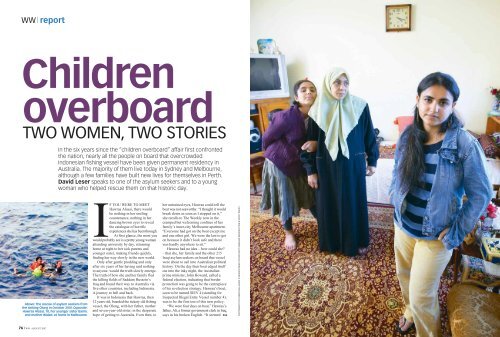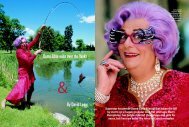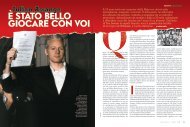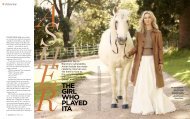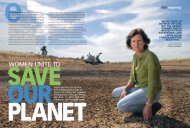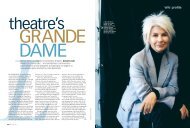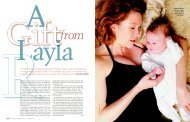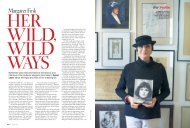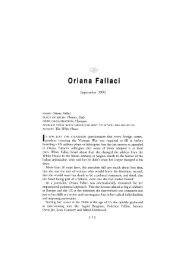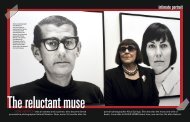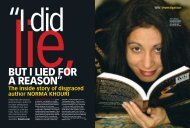Children Overboard - David Leser
Children Overboard - David Leser
Children Overboard - David Leser
Create successful ePaper yourself
Turn your PDF publications into a flip-book with our unique Google optimized e-Paper software.
WW | report<br />
<strong>Children</strong><br />
overboard<br />
TWO WOMEN, TWO STORIES<br />
Above: The rescue of asylum seekers from<br />
the sinking Olong in October 2001.Opposite:<br />
Hawraa Alsaai, 18, her younger sister Banin,<br />
In the six years since the “children overboard” affair first confronted<br />
the nation, nearly all the people on board that overcrowded<br />
Indonesian fishing vessel have been given permanent residency in<br />
Australia. The majority of them live today in Sydney and Melbourne,<br />
although a few families have built new lives for themselves in Perth.<br />
<strong>David</strong> <strong>Leser</strong> speaks to one of the asylum seekers and to a young<br />
woman who helped rescue them on that historic day.<br />
IF YOU WERE TO MEET<br />
Hawraa Alsaai, there would<br />
be nothing in her smiling<br />
countenance, nothing in her<br />
dancing brown eyes to reveal<br />
the catalogue of horrific<br />
experiences she has been through.<br />
At first glance, the most you<br />
would probably see is a pretty young woman<br />
attending university by day, returning<br />
home at night to her sick parents and<br />
younger sister, making friends quickly,<br />
finding her way slowly in the new world.<br />
Only after gentle prodding and only<br />
after six years of her having said nothing<br />
to anyone, would the truth slowly emerge.<br />
The truth of how she and her family fled<br />
the killing fields of Saddam Hussein’s<br />
Iraq and found their way to Australia via<br />
five other countries, including Indonesia.<br />
A journey to hell and back.<br />
It was in Indonesia that Hawraa, then<br />
12 years old, boarded the rickety old fishing<br />
vessel, the Olong, with her father, mother<br />
and seven-year-old sister, in the desperate<br />
hope of getting to Australia. Even then, to<br />
her untrained eyes, Hawraa could tell the<br />
boat was not seaworthy. “I thought it would<br />
break down as soon as I stepped on it,”<br />
she recalls to The Weekly now in the<br />
cramped but welcoming confines of her<br />
family’s inner-city Melbourne apartment.<br />
“Everyone had got on the boat except me<br />
and one other girl. We were the last to get<br />
on because it didn’t look safe and there<br />
was hardly anywhere to sit.”<br />
Hawraa had no idea – how could she?<br />
– that she, her family and the other 215<br />
Iraqi asylum seekers on board that vessel<br />
were about to sail into Australian political<br />
history. On the day their boat edged itself<br />
out into the inky night, the Australian<br />
prime minister, John Howard, called a<br />
federal election, indicating that border<br />
protection was going to be the centrepiece<br />
of his re-election strategy. Hawraa’s boat,<br />
soon to be named SIEV 4 (standing for<br />
Suspected Illegal Entry Vessel number 4),<br />
was to be the first test of this new policy.<br />
“We were four days on boat,” Hawraa’s<br />
father, Ali, a former government clerk in Iraq,<br />
says in his broken English. “It seemed<br />
RIGHTS.<br />
SUPPLY & REPRODUCTION MANAGED PARTY LTD/3RD NEWSPIX/NEWS © GALLAGHER. EAMON BY<br />
and mother Widad, at home in Melbourne. <br />
PHOTOGRAPHY<br />
76 | WW AUGUST 2007 WW AUGUST 2007 | 77
more like a week,” Hawraa counters with<br />
a confidence that belies her 18 years. “My<br />
mum had little snacks in her bag, but [apart<br />
from that] there was no food and we all<br />
got seasick. Everyone was throwing up<br />
and we were all so thirsty because there<br />
was hardly any water on board.<br />
“Also we couldn’t sleep,” she continues,<br />
“because we were right near the engine.”<br />
What kept Hawraa’s spirits alive was the<br />
prospect that they would soon find safe<br />
harbour and thus end the nightmare that<br />
had begun with their panic-stricken flight<br />
from Iraq a month earlier. (Already,<br />
Hawraa’s two uncles had been tortured and<br />
killed by Saddam’s Ba’athist guards and<br />
Hawraa’s father was next on the list.)<br />
The first contact with Australia came<br />
the following day, on October 6, 2001, with<br />
the sighting of the “big ship”, as Hawraa<br />
calls it. It was the Australian frigate, the<br />
HMAS Adelaide. By this stage, all the<br />
children on board had become dehydrated<br />
and weak from hunger. Their parents were<br />
pleading to be taken aboard the HMAS<br />
Adelaide, but the crew were under strict<br />
instructions to turn the boat around.<br />
“We just wanted to get help, to get off<br />
the boat,” Hawraa says, “but they brought<br />
us food and water bottles, and then told us<br />
to turn back to Indonesia. We were scared.<br />
We told them we couldn’t go back after<br />
what we had been through.”<br />
For six years, Hawraa has refused to talk<br />
about her ordeal, even to her new Australian<br />
friends, but the recent granting of a permanent<br />
visa to her family, plus her admission into<br />
an Australian university, has given her the<br />
confidence to finally tell her story.<br />
Besides, as she tells The Weekly now,<br />
“It doesn’t hurt as much as it used to.”<br />
What she means is she can now bear to<br />
recall how sick and terrified she was, how<br />
she nearly drowned and how she and her<br />
family lost everything in the water that day –<br />
jewellery, clothes, documents, soft toys …<br />
By the dawn of October 8, the fishing<br />
vessel’s engine had stopped and the two<br />
main pumps had ceased working. There<br />
was a gaping hole in the hull and another<br />
below the waterline. Passengers had been<br />
bailing and pumping all night and day, but<br />
the water had still kept rising. In total, there<br />
were 56 children on board, including a<br />
three-week-old infant and a 12-week-old<br />
baby. The hysteria was mounting.<br />
One woman had begun vomiting blood.<br />
Others had been threatening to suicide. The<br />
men had been begging the sailors to rescue<br />
their wives and children for the past 24 hours,<br />
but the navy had its orders – no one was to<br />
be rescued unless the boat had sunk and<br />
everyone was in the water. (This order was<br />
to be ignored later, when two desperate<br />
mothers pushed their babies into the arms<br />
of two sailors as the boat was foundering.)<br />
By about 5pm, the fishing vessel began to<br />
break up and the asylum seekers were ordered<br />
to abandon ship. “I didn’t want to jump,”<br />
Hawraa says. “I saw everyone jumping in<br />
and I was so scared looking at the water.”<br />
Hawraa was the last person to throw<br />
herself into the sea. Just before she did,<br />
she noticed the shape of a person dropping<br />
into the ocean from the second deck of the<br />
frigate. It was an awesome sight. “I saw<br />
that lady jump into the water to rescue<br />
people,” she says with incredulity.<br />
Laura Whittle grew up in<br />
Tasmania and joined the<br />
Australian Navy in 1999,<br />
aged 17. It was the only thing<br />
she ever really wanted to do.<br />
On October 6, 2001, she<br />
was the navigator’s yeoman and gunner on<br />
board HMAS Adelaide, when it happened<br />
to spot a small wooden fishing vessel heading<br />
towards Christmas Island. Initially, she<br />
couldn’t see how many people were on<br />
board, but it would have made no difference<br />
– HMAS Adelaide was invested with<br />
the task of keeping boats like this out of<br />
Australian waters, as part of the federal<br />
government’s new border protection policy.<br />
This boat, however, was proving<br />
stubborn. The boarding party that had<br />
come bearing food and water failed to get<br />
the captain to turn back towards Indonesia.<br />
People were yelling and screaming for<br />
help. It was now up to Laura to show them<br />
the other face of the Australian warship.<br />
“I fired some warning shots to show them<br />
we meant business,” Laura recalls now,<br />
speaking publicly for the first time about an<br />
incident that has long tormented her. “We<br />
could see their faces and the screaming was<br />
just horrific. They were yelling, ‘Help us!’<br />
and, at one point, it was more deafening than<br />
the 50-calibre machine gun.”<br />
Laura readily admits that, at this stage of<br />
the stand-off, she was largely indifferent to<br />
the asylum seekers’ fates. She had a job to<br />
do and that was to keep illegal vessels out.<br />
“I can remember thinking – and this is a<br />
horrible thought – ‘Just go away, I want to<br />
go off watch and go to sleep’. At that time, I<br />
wasn’t thinking about them as people.” At<br />
least not until a father suddenly appeared <br />
“I CAN REMEMBER THINKING – AND THIS<br />
IS A HORRIBLE THOUGHT – ‘JUST GO<br />
AWAY, I WANT TO GO OFF WATCH AND<br />
GO TO SLEEP’. AT THAT TIME, I WASN’T<br />
THINKING ABOUT THEM AS PEOPLE.”<br />
78 | WW AUGUST 2007 WW AUGUST 2007 | 79<br />
PHOTOGRAPHY BY PIP BLACKWOOD.<br />
HMAS Adelaide<br />
crew member,<br />
Laura Whittle,<br />
jumped 12 metres<br />
into choppy seas<br />
to rescue the<br />
asylum seekers.
on the upper level of the fishing vessel<br />
holding his young daughter in his arms.<br />
“When I saw that man with his daughter,<br />
it just made my heart melt,” Laura recalls<br />
now. “The girl had on a pink jacket and she<br />
had curly hair, and it was like the father<br />
was saying to our guys in the inflatable<br />
rafts, ‘Take her, take her’. That was the<br />
gesture he was making – ‘Just take her’.<br />
It was like `Give her a chance’ and it was<br />
then that I moved out of work mode and<br />
the humanity began to kick in.<br />
“I thought, ‘He just wants to save his<br />
little girl. He just wants her to have a better<br />
life.’ The boat was jam-packed full of<br />
people and people were screaming out,<br />
but he stood out – a tall figure holding<br />
his little girl – and it was sort of surreal.<br />
Everything just went quiet.”<br />
Shortly afterwards, the boat began to<br />
break up and sink. Laura Whittle was<br />
stunned into action. “I was standing next<br />
to Commander [Norman] Banks and he<br />
was overwhelmed, and I was thinking, ‘I<br />
have to do something’, and so I took my<br />
boots off and looked at Commander<br />
Banks, and he looked at me as if to say,<br />
‘Yes, please, do it’, and so I leaped off.”<br />
Laura Whittle had decided to jump<br />
into the Indian Ocean without a lifejacket<br />
and from a height of 12 metres, roughly<br />
equivalent to a four storey building. It<br />
was a leap of frightening, epic proportions,<br />
especially given the choppy seas, the<br />
undertow from the ship and the number<br />
of bodies floundering below.<br />
“I remember pin dropping and, when I<br />
hit the water, I was thinking ‘Oh, my God’<br />
… I kept going down and didn’t think I<br />
would ever come back up.”<br />
Once she had surfaced, Laura began<br />
pulling people into the life raft, only to<br />
realise that, a few metres away, a woman<br />
and her son were about to go under. The<br />
woman’s name was Fadeelah Al Hussaini<br />
and her eight year-old son, Hassan.<br />
“Putting a name to the face … well, it<br />
makes it more human, doesn’t it?” Laura<br />
says now, visibly overcome with the impact<br />
of learning the names of those she rescued.<br />
“I’m just overwhelmed hearing their names<br />
… I could see her struggling with her child<br />
and I knew they needed help. It all happened<br />
so fast, but it was like someone had to do<br />
something. It was just commotion out there<br />
… but it all started for me from the minute<br />
that man held up his little girl.<br />
“That’s when I started to think differently,<br />
‘How could somebody be so desperate to<br />
do something like this, to head towards the<br />
unknown with their children on a rickety<br />
boat and to put everything at risk?’ They<br />
Refugees from the<br />
sinking Indonesian<br />
fi shing boat being<br />
rescued by sailors<br />
from HMAS Adelaide.<br />
“THEY MUST HAVE BEEN COMING FROM SOMETHING<br />
TERRIBLE AND IT MADE ME THINK, ‘THIS ISN’T RIGHT’.”<br />
must have been coming from something<br />
terrible and it made me think, ‘This isn’t<br />
right, this isn’t how things should be’.”<br />
After their dramatic rescue<br />
at sea, Hawraa and her<br />
family, together with the<br />
other 215 Iraqi asylum<br />
seekers, were transferred<br />
to a basketball hall on<br />
Christmas Island, where they were kept<br />
for 11 days while the details of their secret<br />
transfer to Manus Island in Papua New<br />
Guinea were thrashed out. “They told us<br />
we were going to Sydney,” Hawraa says<br />
now, unable to conceal her dismay. “And<br />
we were dancing and singing. That was the<br />
first day we slept because everyone was<br />
so relieved. But then they put us on a plane<br />
and we were taken to Manus Island.”<br />
When the doors of the plane opened,<br />
the asylum seekers were greeted with a<br />
blast of hot air and the sight of a group of<br />
Papuans with beetlenut-red teeth ordering<br />
them out the doors. “I was really scared,”<br />
Hawraa continues. “I could see black people<br />
with red in their teeth and I thought it was<br />
blood in their mouths. I thought they were<br />
going to kill us.”<br />
For the next three months, the family<br />
was housed in a disused World War II<br />
naval base and it was here that Hawraa<br />
became increasingly sick with what was<br />
eventually diagnosed as diabetes. “One day,<br />
I went into a coma,” she recalls. “I was<br />
just standing near the door and everything<br />
just went blank. I can remember screaming<br />
my mum’s name, being caught from behind<br />
and then waking up in bed.”<br />
The conditions were appalling. For the<br />
first few weeks, drinking water was scarce,<br />
the food barely edible and the second-hand<br />
clothes putrid. After one-and-a-half months,<br />
they were given a television set, only to be<br />
confronted with the greatest indignity of all<br />
– to their horror, they discovered they’d been<br />
accused by the Australian government of<br />
throwing their children into the sea.<br />
“I was very angry and upset and hurt<br />
when I saw this,” says Hawraa’s father, Ali<br />
Alsaai, speaking to The Weekly with the<br />
help of his daughter’s translation skills. “I<br />
couldn’t believe that the prime minister<br />
would lie to 20 million people. Why would<br />
we throw our children into the water?” His<br />
wife, Widad, a nurse by training, opens her<br />
palms in a gesture of disbelief and says<br />
quite simply, “I love my children”.<br />
The accusations only served to reinforce<br />
the deep resentment the asylum seekers were<br />
already feeling towards the government.<br />
Cut off from lawyers and the media, there<br />
was no way of correcting the record.<br />
After three-and-a-half months on Manus<br />
Island, Hawraa was sent to a hospital in<br />
Cairns and her family placed under guard<br />
in a nearby hotel. Shortly after their arrival,<br />
Hawraa’s mother prevailed on the guards to<br />
let them telephone her three sons, Hawraa’s<br />
three brothers, in Iraq. When she finally got<br />
through to them, she discovered to her horror<br />
that – in the absence of any news from<br />
Indonesia or Australia – she and her family<br />
had all been given funerals in Iraq. “Everyone<br />
started crying on the phone,” Hawraa says.<br />
“They all thought we were dead.”<br />
Four months after arriving in Cairns, the<br />
family was transferred to Melbourne’s<br />
Maribyrnong Detention Centre, where they<br />
would remain for the next one-and-a-half<br />
years. For five months, they would be housed<br />
in one small room, a condition which <br />
80 | WW AUGUST 2007 WW AUGUST 2007 | 81<br />
© NEWSPIX/NEWS LTD/3RD PARTY MANAGED REPRODUCTION & SUPPLY RIGHTS.
While her daughters have<br />
adapted well to their new<br />
home, Widad, a trained nurse,<br />
agonises over the fate of her<br />
three sons still in Iraq.<br />
almost sent the family mad. “There was<br />
nothing to do,” Hawraa says. “I would<br />
always just sleep and get up. It was a relief<br />
to have a visitor, just to see a smiling face.”<br />
Six months into their Melbourne detention,<br />
Hawraa and her sister, Banin, finally got their<br />
wish and were allowed to go to school, but<br />
always under guard. “I begged them once<br />
to let me walk from the detention centre to<br />
school,” Hawraa says, “but they wouldn’t.”<br />
Hawraa soon made friends at Footscray<br />
City College, but none of them knew she<br />
was living in a detention centre. She wanted<br />
that kept secret. “I thought they would stop<br />
liking me.” The opposite was true, but how<br />
was she to know? After school, she would<br />
return to the detention centre – sometimes<br />
in an armoured van – shame-faced and in<br />
tears. She had no sense of a future.<br />
Then, suddenly, without warning,<br />
the family was sent back to Papua New<br />
Guinea, where they were put up in a hotel<br />
for two weeks and told to wait for the<br />
results of their applications for temporary<br />
protection visas. By week’s end, the<br />
visas had been approved. They could go<br />
anywhere in Australia they liked. They<br />
chose Footscray. It was where Hawraa<br />
and her sister had made friends.<br />
“We were told we didn’t have to go<br />
back to the detention centre,” says Hawraa<br />
now. “Banin and I were so happy because<br />
we could go shopping together.” Not that<br />
this was without its complications. Both<br />
children had become so accustomed to<br />
“WHAT IS REMARKABLE IS ... 220-ODD PEOPLE WERE PUT<br />
IN RISK OF THEIR LIVES UNDER THE NOSE OF ONE OF<br />
OUR NAVY SHIPS ... IT’S A MIRACLE NO ONE DROWNED.”<br />
being under guard, they didn’t know what to<br />
do sometimes without it. “I was so used<br />
to having someone watch me all the time<br />
that I was always looking around to see<br />
who was beside me,” Hawraa says.<br />
Hawraa excelled in her studies and was<br />
able to make lasting friendships at Footscray<br />
City College. To the former Year 8 coordinator,<br />
Peter Noss, she was a credit<br />
both to the school and to her family. “She<br />
was the best student,” he tells The Weekly<br />
now. “When she came to us, she was only<br />
speaking English for a couple of months<br />
and she became so good. All she ever<br />
wanted to do was become a doctor, so she<br />
could help people.”<br />
After returning to Australia from PNG,<br />
Hawraa and her family had moved into a<br />
tiny two-bedroom apartment in Footscray,<br />
furnished with donations from charity groups<br />
such as St Vincent de Paul. Peter could see<br />
how impoverished they were. He decided<br />
to broach the subject with Hawraa herself.<br />
“Hawraa came to school one day and I<br />
asked her what she’d had for lunch. She<br />
told me she’d had an egg. I said, ‘Well,<br />
I’m coming around tonight to see what<br />
food you have’ and when I got there and<br />
opened the fridge door, the only thing they<br />
had in it was water. That was just after<br />
they’d been released from the detention<br />
centre. So I passed the hat around among<br />
the teachers and we raised $500, just to<br />
give them a bit of dignity.”<br />
Hawraa and her family<br />
live gratefully, but<br />
uncertainly, with their<br />
mixed blessings. On the<br />
one hand, they agonise<br />
over the fate of Hawraa’s<br />
three brothers and sister-in-law, who were<br />
forced to remain behind in Iraq when they<br />
fled. They know their home in Najaf has<br />
been destroyed, a cousin killed by a stray<br />
bullet and their country all but ruined.<br />
Also, Hawraa’s parents have not been<br />
well. Ali, her father, has had heart surgery<br />
and her mother, Widad, struggles with<br />
diabetes and high cholesterol.<br />
Against this is the fact that both daughters<br />
have adjusted well to their new country.<br />
Banin is happy in high school and, at the<br />
beginning of this year, Hawraa began a<br />
double major in biomedical science and<br />
engineering at Melbourne’s Swinburne<br />
University of Technology. She has decided<br />
not to become a doctor, but rather to pursue<br />
medical research. A few months ago, the<br />
family was given permanent residency.<br />
Like all those on board that fishing<br />
vessel six years ago, the family still finds<br />
it difficult to understand how or why the<br />
Australian government allowed them to<br />
be so mistreated and why it was that they<br />
accused them of wanting to harm their<br />
children. “Why would we come here and<br />
then throw children into the water?” Hawraa<br />
says, speaking on behalf of all the parents<br />
on that boat. “That is what I couldn’t believe<br />
– that people would think this is true. That’s<br />
why I think he [Mr Howard] should<br />
apologise. It’s the least he could do<br />
because that hurts. It hurts very much.”<br />
Tony Kevin, a former Australian diplomat,<br />
is among the many prominent Australians<br />
critical of the Howard government for its<br />
harsh approach to refugees over the past<br />
decade. His primary concern in the children<br />
overboard affair, however, has not been<br />
the use of incorrect photos, nor the false<br />
accusations made against the refugees,<br />
but rather the brinkmanship engaged in<br />
during that 24-hour period when Hawraa’s<br />
boat was at risk of sinking.<br />
“What is remarkable,” he tells The<br />
Weekly now, “is not the brouhaha over<br />
misrepresented photos, but that 220-odd<br />
people were put in risk of their lives under<br />
the nose of one of our navy ships. That’s<br />
why the [HMAS Adelaide] crew became<br />
so distressed … because they knew they<br />
had been forced to take part in a terribly<br />
wrong procedure. Those people were kept<br />
in their boat for 24 hours rather than allowed<br />
to be put on HMAS Adelaide for their safety.<br />
It’s a miracle that no one drowned.”<br />
For Hawraa and her family, it’s a double<br />
miracle. Just before they left Indonesia on<br />
that ramshackle vessel, they held a family<br />
conference to see whether they should take<br />
the next boat heading for Christmas Island.<br />
“We nearly went on the next one, but we<br />
didn’t want to miss our chance,” Hawraa says.<br />
The next boat was, of course, the vessel<br />
dubbed SIEV X, which left south Sumatra<br />
on October 18, crammed beyond capacity<br />
with 421 people, many of whom had been<br />
forced onto the vessel at gunpoint by<br />
Indonesian officials. The boat sank the<br />
following day, after a hellish night of<br />
desperate bailing and last, tearful prayers.<br />
Among the 353 people who perished were<br />
150 women and children, a number of<br />
whom had relatives and friends on board<br />
Hawraa’s boat.<br />
As one survivor was to recall later,<br />
wherever you looked, you could “see dead<br />
children like birds floating on the water”. To<br />
this day, we still don’t know their names. ■<br />
PHOTOGRAPHY BY EAMON GALLAGHER.<br />
82 | WW AUGUST 2007 WW AUGUST 2007 | 83


